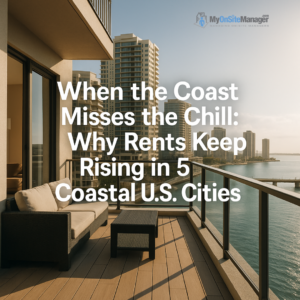While U.S. rent prices have declined year-over-year for nearly two years, five major coastal metro areas continue to defy the trend—remaining among the least affordable in the country Realtor+9Yahoo+9New York Post+9.
1. The National Downtrend
-
As of May 2025, the median U.S. rent hovered around $1,705/month, down about 1.7% year-over-year from its August 2022 peak—but still nearly 20% above pre-pandemic levels Redfin+2Newnan CEO+2Realtor+2.
-
This marks the 22nd consecutive month of annual decline in rental costs for 0–2 bedroom homes Adelaide Now+7Realtor+7The Times+7.
-
The slowdown is largely attributed to a surge in new multifamily construction and elevated vacancy rates—which soften landlords’ pricing power Yahoo+2Realtor+2Apartment List+2.
2. Coastal Outliers Still Seeing Rent Appreciation
The five coastal metros where rents continue to climb are:
-
Miami, FL – consistently tops national rent inflation rankings.
-
New York City, NY – remains one of the most expensive rental markets.
-
Los Angeles, CA – commanding high prices despite moderate growth.
-
Boston, MA – tight supply keeps rents elevated.
-
(The NY Post article references five large coastal metros, though some reports vary in ranking.) Newnan CEO+15Yahoo+15New York Post+15Apartments.com+4Realtor+4Construction Coverage+4Apartments.com+2Manistee News Advocate+2The Sun+2New York Post
-
Miami was identified as the least affordable major metro for renters in April 2025 Realtor+2Yahoo+2Redfin+2.
-
New York City maintains one of the highest median rents, with NYC metro rates over $2,900—a 2.5% increase year-over-year as of May .
-
Boston experienced a modest rent climb: +0.6% in May, around $3,000/month median .
-
Los Angeles remains high-priced (~$2,700 median), even as growth slows .
3. Why These Markets Buck the Trend
-
Demand dynamics: Coastal metros attract ongoing influxes of professionals, students, and international migrants.
-
Supply constraints: Limited land, dense development zones, and restrictive regulations suppress new housing.
-
Strong local economies: These areas benefit from thriving industries—tech, finance, healthcare, and academia—keeping disposable incomes and rent demand high.
-
Tourism & short-term rentals: Cities like Miami and L.A. face stiff competition between long-term rentals and lucrative short-term platforms (Airbnb, etc.), which reduces inventory.
4. Broader Implications
| For Renters | For Investors |
|---|---|
| Relief is coming in most U.S. metros due to cooling demand and rising supply. | Coastal markets still offer income stability due to strong fundamentals. |
| But those in Miami, NYC, Boston, L.A. remain exposed to rent increases and fierce competition. | Entering these markets requires higher capital but can yield steady returns. |
5. What Lies Ahead?
-
New construction rollout and infrastructure projects may gradually ease coastal supply pressures—but development timelines often stretch over years.
-
Macro factors, like steel and aluminum tariffs (now at 50%), could inflate future construction costs, delaying new housing delivery New York Post+8Realtor+8New York Post+8.
-
Post-pandemic remote work trends may continue reshaping where people choose to live—possibly easing demand in mega cities over time.
Takeaway Recommendations
-
Renters should explore emerging inland metros where rents are declining or flat.
-
Investors, while looking to diversify, may still find value in coastal markets—especially if targeting neighborhoods with upcoming development or rezoning potential.
-
Policy-makers need to address supply constraints and regulatory barriers to mitigate affordability issues in coastal hubs.
Source
-
“Rent prices are falling — except for these 5 coastal cities”, New York Post, May 14, 2025 (via: https://nypost.com/2025/05/14/real-estate/rent-prices-are-falling-except-for-these-5-coastal-cities/)

